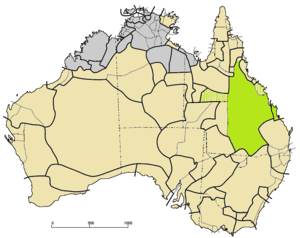Maric languages
- Not to be confused with the Marran languages of the Gunwinyguan family or the Mari languages
| Maran | |
|---|---|
| Geographic distribution: | Coastal Queensland |
| Linguistic classification: |
Pama–Nyungan
|
| Subdivisions: |
|
| Ethnologue code: | 17-118 |
 Maric languages (green) among Pama–Nyungan (tan). The solid area on the coast is Kingkel. The striped areas are Ngaro and Giya on the coast and Guwa and Yanda in the interior, which may be Maric. | |
Maran or Maric is a branch of the Pama–Nyungan family of Australian languages.[1] The well attested Maric languages are clearly related; however, many languages of the area went extinct before much could be documented of them, and their classification is uncertain. The clear Maric languages are:
- Bidyara (numerous varieties)
- Biri (several varieties)
- Warrungu (& Gugu-Badhun, Gudjal)
- (Kingkel?): Darumbal
Dharumbal was added by Bowern (2011); it had been classified in the Kingkel branch of Waka–Kabic. It is not clear if the other Kingkel language, Bayali, is also Maric; Bayali and Darumbal are not close.
Unclassified languages
Ngaro and Giya (Bumbarra), spoken on the coast, may also have been Maric, the latter perhaps a dialect of Biri.[2]
Of the interior, to the west, Breen (2007) writes of "Karna–Mari fringe" languages which are "a discontinuous group of languages, mostly poorly attested, scattered between Karnic and Mari languages but not showing much connection with either or with one another. The only one well attested is also the most remote geographically, Kalkutungu".[3] This includes the Ngura languages, several of which belong to the Karnic branch of Pama–Nyungan. However, Bowern (2011) lists the Badjiri variety as Maric.[4] Other poorly attested interior languages which may have been Maric include Ngaygungu (Dixon 2002),[5] Bindal (Bowern 2011), Barna (Bowern 2011), Dhungaloo (doubtful in Bowern, not listed at AIATSIS), and Yirandhali (Dixon, Bowern); Dixon's "Greater Maric" area listed in Bowern (2011) also includes Guwa (Goa) and Yanda. See also Karnic languages for additional varieties from the area.
See also
- Pama–Maran languages
References
- ↑ RMW Dixon (2002), Australian Languages: Their Nature and Development, p xxxiii
- ↑ Giya at the Australian Indigenous Languages Database, Australian Institute of Aboriginal and Torres Strait Islander Studies
- ↑ Badjiri at the Australian Indigenous Languages Database, Australian Institute of Aboriginal and Torres Strait Islander Studies
- ↑ Bowern, Claire. 2011. "How Many Languages Were Spoken in Australia?", Anggarrgoon: Australian languages on the web, December 23, 2011 (corrected February 6, 2012)
- ↑ Dixon, R. M. W. (2002). Australian Languages: Their Nature and Development. Cambridge University Press. p. xxxiii.